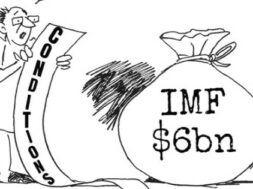
Roving Periscope: Is Pakistan trying to trick the IMF into providing the USD 6 billion loan?
Virendra Pandit
New Delhi: Is a broke Pakistan trying to trick the International Monetary Fund (IMF) into a bailout package of USD 6 billion?
If Pakistan gets this IMF loan, it will be Islamabad’s 23rd bailout since 1950, showing the South Asian nation has come close to bankruptcy at least 23 times since it broke away from India in 1947.
Pakistan has claimed that its four ‘friendly countries’—whom it has not identified—might extend a USD 4 billion lifeline. During prolonged discussions with the IMF, the global lender was worried that Pakistan already had a balance-of-payment problem to the tune of USD 4 billion—meaning that Islamabad must settle this crisis before it could get the IMF loan.
So dire is the financial condition of Pakistan that it’s traditional ‘friends’ like China and Saudi Arabia have, despite assurances, cautiously refrained from giving any aid further, leaving Islamabad high and dry.
This may have forced Pakistan to trick the IMF. Talking about his negotiations with the IMF last week, Finance Minister Misbah Ismail used interesting words—“think,” “perhaps”—which experts took with a pinch of salt.
“We think we will get USD 1.2 billion in deferred oil payment from a friendly country. We think that a foreign country will invest between USD 1.5 to USD 2 billion in stocks on a G2G (government-to-government) basis, another friendly country will perhaps give us gas on deferred payment, and yet another friendly country will make some deposits,” he said without naming the four friendly nations, the media reported.
Two days after the cash-strapped Islamabad reached a reported “deal” with the IMF last week—that the global lender could provide a USD 6 billion package if Pakistan could set off its USD 4 billion balance-of-payments crisis—Ismail said Pakistan might get USD 4 billion from ‘friendly countries’ this month to bridge a gap in foreign reserves as highlighted by the global lender.
Depleting foreign exchange reserves, a widening current account deficit (CAD), and the Pakistan rupee’s relentless depreciation against the US dollar—on Monday, it was PKR 216 per USD—have left the Muslim nation facing a severe balance-of-payments crisis.
Last Saturday, the FM said there is a USD 4 billion gap. “We will, God willing, fill this gap in the month of July,” he said.
On Thursday last week, after months of negotiations, Pakistan reached a preliminary staff-level agreement with the IMF for the revival of the USD 6 billion loan facility.
The agreement paves the way for releasing the much-awaited USD 1.18 billion loan tranche that had been on hold since earlier this year.
Dawn newspaper reported that the IMF Board is also considering adding USD 1 billion to a USD 6 billion program agreed on in 2019.
Without the IMF deal, which should open up other avenues for external finance, Ismail said, the country could have headed towards default.
The FM claimed Pakistan would also get around USD 6 billion from multilateral lenders this fiscal year, including USD 3.5 billion from the Asian Development Bank and USD 2.5 billion from the World Bank.
He said USD 400 million to USD 500 million was also expected from the Asian Infrastructure Investment Bank, while the Islamic Development Bank might increase the funding.
He hoped the rupee would strengthen against the dollar soon after the IMF agreement was finalized, as expected in July.
Besides, he said the government aimed to curb energy imports from USD 3.7 billion in June to USD 2.7 billion this month, which was also expected to take some pressure off the local currency.














